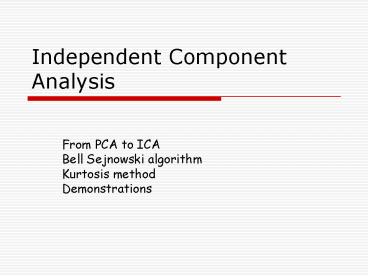Independent Component Analysis - PowerPoint PPT Presentation
1 / 39
Title:
Independent Component Analysis
Description:
Independent Component Analysis. From PCA to ICA. Bell Sejnowski algorithm. Kurtosis method ... ICA based on Kurtosis. Oja and Hyvarinen. Independent Component Analysis ... – PowerPoint PPT presentation
Number of Views:431
Avg rating:3.0/5.0
Title: Independent Component Analysis
1
Independent Component Analysis
- From PCA to ICA
- Bell Sejnowski algorithm
- Kurtosis method
- Demonstrations
2
(No Transcript)
3
(No Transcript)
4
(No Transcript)
5
(No Transcript)
6
(No Transcript)
7
(No Transcript)
8
(No Transcript)
9
(No Transcript)
10
(No Transcript)
11
Bell and Sejnowski 1995
Consider yg(x)noise with f depending on
w I(yx)H(y)- H(yx) H(yx)E_x E_yx -log
P(yx)
12
(No Transcript)
13
(No Transcript)
14
(No Transcript)
15
(No Transcript)
16
(No Transcript)
17
(No Transcript)
18
(No Transcript)
19
ICA based on KurtosisOja and Hyvarinen
20
(No Transcript)
21
(No Transcript)
22
(No Transcript)
23
(No Transcript)
24
(No Transcript)
25
(No Transcript)
26
(No Transcript)
27
(No Transcript)
28
(No Transcript)
29
(No Transcript)
30
(No Transcript)
31
Independent Component Analysis
An overview of applications of ICA to biological
data and general data mining, Computational
Neurobiology Laboratory Salk Institute, La Jolla
CA (April, 1999). Enter Enter to advance,
up-arrow to rewind.
- Perform blind separation of signals recorded
at multiple sensors
- Use minimal assumptions about the characteristics
of the signal sources.
32
Principle Maximize Information
- Q How to extract maximum information from
multiple visual channels?
- ICA produces brain-like visual filters for
natural images.
- A ICA does this -- it maximizes joint entropy
minimizes mutual information between output
channels (Bell Sejnowski, 1995).
Set of 144 ICA filters
33
ICA versus PCA
- Independent Component Analysis (ICA) finds
directions of maximal independence in
non-Gaussian data (higher-order statistics).
- Principal Component Analysis (PCA) finds
directions of maximal variance in Gaussian data
(second-order statistics).
34
Example Audio decomposition
Perform ICA
Mic 1
Mic 2
Mic 3
Mic 4
Terry
Scott
Te-Won
Tzyy-Ping
Play Mixtures
Play Components
35
Electroencephalography (EEG)
Artifacts
- ICA separates brain signals from artifacts.
Brain signals
- Permits study of brain activity in noisy
conditions.
- Allows monitoring of multiple brain processes.
36
Functional Brain Imaging
- Functional magnetic resonance imaging (fMRI) data
are noisy and complex.
- ICA identifies concurrent hemodynamic processes.
- Does not require a priori knowledge of time
courses or spatial distributions.
37
Data Mining
- ICA was applied to Armed Forces Vocation Aptitude
Battery (ASVAB) test scores and Navy Fire Control
School grades.
- Two ICA components contributed to final school
grade.
- ICA may suggest more efficient and balanced
selection criteria.
38
This presentation by
- Scott Makeig, Naval Health Research Center, San
Diego - Tzyy-Ping Jung, Institute for Neural Computation,
UCSD, La Jolla CA - Te-Won Lee, Salk Institute, La Jolla CA
- Sigurd Enghoff, Salk Institute
- Terrence J. Sejnowski, Salk Institute UCSD
39
From Barak Pearlmutter
- Contextual ICA
- The first demo applies the Contextual ICA blind
source separation algorithm. Lucas Parra and I
digitally extracted ten five-second clips from
ten audio CDs. These were digitally mixed,
without time delays or echos, and with random
gains, to form the output of a synthetic
microphone. Ten such microphone outputs were
synthesized. These synthetic microphone outputs
formed the input to the Bell-Sejnowski
Independent Components Analysis algorithm. The
sources are somewhat separated in the output of
the Bell-Sejnowski ICA algorithm, but not fully. - The same synthetic microphone outputs were then
used as input to our new cICA algorithm (see my
publications page for technical details). The
sources are almost fully separated in the output
of cICA.































